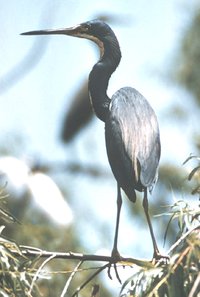Tricolored Heron
|
|
| Tricolored Heron | ||||||||||||||
|---|---|---|---|---|---|---|---|---|---|---|---|---|---|---|
 | ||||||||||||||
| Scientific classification | ||||||||||||||
| ||||||||||||||
| Binomial name | ||||||||||||||
| Egretta tricolor (Statius Muller, 1776) |
The Tricolored Heron, Egretta tricolor, is a small heron. It is a resident breeder in the Caribbean including the Gulf states of the USA. There is post-breeding dispersal to well north of the nesting range.
Tricolored Heron's breeding habitat is sub-tropical swamps. It nests in colonies, often with other herons, usually on platforms of sticks in trees or shrubs. In each clutch 3-7 eggs are typically laid.
This species is about 56 cm long, with a 96 cm wingspan. It is a medium-large, long-legged, long-necked heron with a long pointed yellowish or greyish bill with a black tip. The legs and feet are dark.
Adults have a blue-grey head, neck, back and upperwings, with a white line along the neck. The belly is white. In breeding plumage, they have long blue filamentous plumes on the head and neck, and buff ones on the back.
Tricolored Heron stalks its prey in shallow or deeper water, often running as it does so. It eats fish, crustaceans, reptiles and insects.nl:Driekleurenreiger
